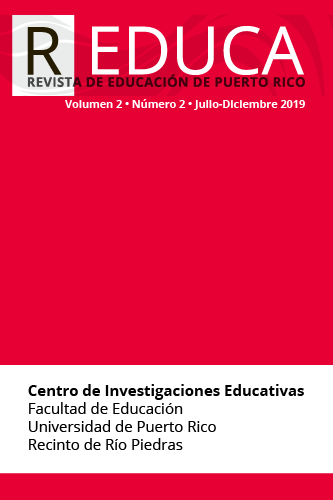Résumé
El aprendizaje basado en estudio de caso ha demostrado mejorar el interés y la comprensión de los estudiantes en cursos de ciencia. Sin embrago, es poca la literatura que evidencie la efectividad de divo método en instituciones de educación superior que atienden a estudiantes hispanos. Con el objetivo de promover el desarrollo de destrezas analíticas, se utilizó el caso "Those Old Kentucky Blues" y una prueba para determinar el aprendizaje y comprensión de los estudiantes en el tópico de genética mendeliana. El análisis de las puntuaciones demostró un aprovechamiento significativo para los estudiantes expuestos al estudio de caso en comparación con el grupo control. Por lo tanto, el método resulta efectivo para la comprensión de la información en estudiantes hispanos, mejorando la percepción y el aprendizaje de tópicos biológicos de alta dificultad.
Références
Abraham, J. K, Perez, K. E & Price, R. M. (2014). The dominant concept inventory: A tool for assessing undergraduate student alternative conceptions about dominance in Mendelian and population genetics. CBE-Life Sciences Education, 13(2), 349-358. doi: https://dx.doi.org/10.1187%2Fcbe.13-08-0160
Browning, M. E. & Lehman, J. D. (1988). Identification of student misconceptions in genetics problem solving via computer program. Journal of Research in Science Teaching, 25(9), 747-761. doi: https://doi.org/10.1002/tea.3660250905
Cendan, J. C., Silver, M. & Ben-David, K. (2011). Changing the student clerkship from traditional lectures to small group case-based sessions benefits the student and faculty. Journal of Surgical Education, 68(2), 117-120. doi: https://doi.org/10.1016/j.jsurg.2010.09.011
DiMatteo, L. A. & Anenson, T. L. (2007). Teaching law and theory through context: Contract clauses in legal studies education. Journal of Legal Studies Education, 24(1), 19-57. doi: https://doi.org/10.1111/j.1744-1722.2007.00033.x
Hilvano, N. T., Mathis, K. M. & Schauer, D. P. (2014). Collaborative learning utilizing case-based problems. Bioscene: Journal of College Biology Teaching, 40(2), 22-30. Disponible en https://eric.ed.gov/?id=EJ1069979
Karagöz, M. & Çakir, M. (2011). Problem solving in Genetics: Conceptual and procedural difficulties. Educational Sciences: Theory & Practices, 11(3), 1668-1674. Recuperado de https://eric.ed.gov/?id=EJ936343
Knight, J. D., Fulop, R. M., Márquez-Magaña, L. & Tanner, K. D. (2008). Investigative cases and student outcomes in an upper-division cell and molecular biology laboratory course at a minority-serving institution. CBE-Life Science Education, 7, 382-393. doi: https://doi.org/10.1187/cbe.08-06-0027
Knipples, M. C. P. J., Waarlo, A. J. & Boersma, K. T. (2005). Design criteria for learning and teaching genetics. Journal of Biological Education, 39(3), 108-112. doi: https://doi.org/10.1080/00219266.2005.9655976
Könings, K. D., Wiers, R. W., van de Wiel, M. W. J. & Schmidt, H. G. (2005). Problem-based learning as a valuable educational method for physically disabled teenagers? The discrepancy between theory and practice. Journal of Developmental and Physical Disabilities, 17(2), 107-117. doi: https://doi.org/10.1007/s10882-005-3683-6
Marra, R., Jonassen, D. H., Palmer, B. & Luft, S. (2014). Why problem-based learning works: theoretical foundations. Journal of Excellence in Collage Teaching, 25(3-4), 221-238. DOI: http://doi.org/10.1007/s10882-005-3683-6
Murray-Nseula, M. (2011). Incorporating case studies into an undergraduate genetics course. Journal of Scholarship of Teaching and Learning, 11(3), 75-85. Recuperado de https://scholarworks.iu.edu/journals/index.php/josotl/article/view/1830
Newman, D. L., Catavero, C. M. & Wright, L. K. (2012). Students fail to transfer knowledge of chromosome structure to topics pertaining to cell division. CBE-Life Sciece Education, 11(4), 425-436. doi: https://doi.org/10.1187/cbe.12-01-0003
Pai, A. (2009). Evolution in action, a case study based advanced biology class at Spelman College. Journal of Effective Teaching, 9(2), 54-68. Recuperado de https://uncw.edu/jet/articles/vol9_2/pai.htm
Pierrakos, O., Zilberberg, A. & Anderson, R. (2010). Understanding undergraduate research experiences through the lens of problem-based learning: Implications of curriculum. Interdisciplinary Journal of Problem-Based Learning, 4(2), 35-62. DOI: https://doi.org/10.7771/1541-5015.1103
Reynolds, J. M. & Hancock, D. R. (2010). Problem-based learning in higher education environmental biotechnology course. Innovations in Education and Teaching International, 47(2), 175-186. DOI: https://doi.org/10.1080/14703291003718919
Rybarczyk, B. J., Baines, A. T., McVey, M., Thompson, J. T. & Wilkins, H. (2007). A case-based approach increases student learning outcomes and comprehension of cellular respiration concepts. Biochemistry and Molecular Biology Education, 35(3), 181-186. doi: https://doi.org/10.1002/bmb.40
Smith, M. K., Wood, W. B. & Knight, J. K. (2008). The genetics concept assessment: a new concept inventory for gauging student understanding of genetics. CBE- Life Sciences Education, 7(4), 422-430. doi: https://doi.org/10.1187/cbe.08-08-0045
Smith, M. U. (1991). Comment on "identification of student misconceptions in genetics problem solving via computer program". Journal of Research in Science Teaching, 28(4), 383-384. DOI: https://doi.org/10.1002/tea.3660280410
Srinivasan, M., Wilkes, M., Stevenson, F., Nguyen, T. & Slavin, S. (2007). Comparing problem-based learning with case-based learning: Effects of a major curricular shift at two institutions. Academic Medicine, 82(1), 74-82. DOI: https://doi.org/10.1097/01.ACM.0000249963.93776.aa
Stewart, J. H. (1982). Difficulties experienced by high school students when learning basic Mendelian genetics. The American Biology Teacher, 44(2), 80-89. DOI: http://doi.org/10.2307/4447413
Walker, J. D., Cotner, S. H., Baepler, P. M. & Decker, M. D. (2008). A delicate balance: integrating active learning into a large lecture course. CBE-Life Science Education, 7(4), 361-367. doi: https://dx.doi.org/10.1187%2Fcbe.08-02-0004
Williams, M., Haydel-Debarger, A. & Montgomery, B. L. (2011). Exploring middle school students‘ conceptions of the relationship between genetic inheritance and cell division. Science Education, 96(1), 78-103. doi: http://dx.doi.org/10.1002/sce.20465
Wolter, B. H. K., Lundeberg, M. A. & Bergland, M. (2013). What makes science relevant?: Student perception of multimedia case learning in ecology and health. Journal of STEM Education: Innovations and Research, 14(1), 26-35. Recuperado de https://www.jstem.org/jstem/index.php/JSTEM/article/download/1659/1507/
El contenido que aparece en la Revista de Educación de Puerto Rico se distribuye gratuitamente y está disponible bajo las prácticas de acceso abierto, de acuerdo con la licencia de Creative Commons, Atribución-NoComercial 4.0 Internacional (CC BY-NC 4.0). Mediante estos principios, la revista y sus autores permiten a los lectores acceder, reproducir y compartir los textos completos de los artículos. Los usuarios deben dar crédito a los autores de forma razonable sin sugerir que tienen el apoyo de ellos. Bajo ninguna circunstancia, los lectores pueden hacer uso de los contenidos con propósitos comerciales. Los autores conservan los derechos de autor sobre sus trabajos.

